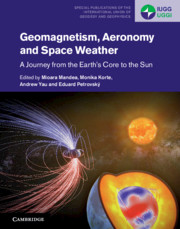Book contents
- Geomagnetism, Aeronomy and Space Weather
- Special Publications of the International Union of Geodesy and Geophysics Series
- Geomagnetism, Aeronomy and Space Weather
- Copyright page
- Contents
- Contributors
- Preface
- Part I Introduction
- Part II Geomagnetic Field
- 4 Geomagnetic Field Sources
- 5 Can Paleomagnetism Distinguish Dynamo Regimes?
- 6 Geomagnetic and Electromagnetic Observations at Ground Level
- 7 Modelling Internal and External Geomagnetic Fields Using Satellite Data
- 8 New Insights in Far-Space Measurements
- Part III Spatial and Temporal Variations of the Geomagnetic Field
- Part IV Space Weather
- Part V Magnetic Fields beyond the Earth and beyond Today
- Index
- References
6 - Geomagnetic and Electromagnetic Observations at Ground Level
from Part II - Geomagnetic Field
Published online by Cambridge University Press: 25 October 2019
- Geomagnetism, Aeronomy and Space Weather
- Special Publications of the International Union of Geodesy and Geophysics Series
- Geomagnetism, Aeronomy and Space Weather
- Copyright page
- Contents
- Contributors
- Preface
- Part I Introduction
- Part II Geomagnetic Field
- 4 Geomagnetic Field Sources
- 5 Can Paleomagnetism Distinguish Dynamo Regimes?
- 6 Geomagnetic and Electromagnetic Observations at Ground Level
- 7 Modelling Internal and External Geomagnetic Fields Using Satellite Data
- 8 New Insights in Far-Space Measurements
- Part III Spatial and Temporal Variations of the Geomagnetic Field
- Part IV Space Weather
- Part V Magnetic Fields beyond the Earth and beyond Today
- Index
- References
Summary
In Chapter 6.1 we briefly review the main instruments used in today’s ground-based geomagnetic observations, focusing on their performances and working principles (from a user’s point of view). Next, the major measurement methods and systems currently in use will be introduced, with a focus on the latest developments in the field. In Chapter 6.2 electromagnetic (EM) methods will be discussed to study the electrical conductivity structure within Earth in a wide depth range and can be measured at the Earth’s surface by magnetometers and telluric electrodes. In Chapter 6.3 a new technique based on differences in instrument responses from ground-based magnetic measurements that extracts the frequency content of the magnetic field with periods ranging from 0.1 to 100 seconds will be discussed. This method enables the study of field line oscillations using the publicly available, worldwide database of geomagnetic observatories.
Keywords
- Type
- Chapter
- Information
- Geomagnetism, Aeronomy and Space WeatherA Journey from the Earth's Core to the Sun, pp. 54 - 83Publisher: Cambridge University PressPrint publication year: 2019



